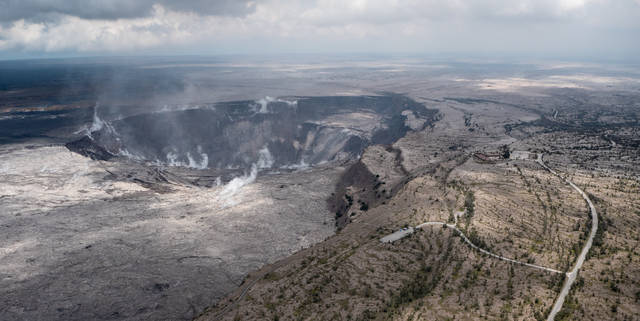The ever-growing Halema‘uma‘u crater already swallowed the Overlook parking lot and might make the Jaggar Museum unusable.
Jessica Ferracane, Hawaii Volcanoes National Park spokeswoman, said the facility on the edge of Kilauea caldera hasn’t been structurally assessed, but staff have witnessed cracks across the viewing deck as well as inside the museum. Artifacts were being removed earlier this week.
“Every single day, we are sustaining damage from these ongoing earthquakes,” she said. “The cracks and the fractures along the overlook of Jaggar go through rock walls down through the ground.”
Ferracane said there is concern the building, which also houses the U.S. Geological Survey’s Hawaiian Volcano Observatory, could slide into the caldera if this activity continues. But even if it doesn’t, it might not be safe to reuse once the park can reopen.
“It’s very doubtful we would ever return to Jaggar Museum and the USGS HVO building,” she said.
“It’s mildly possible it could be reused,” Ferracane added. “I’m not sure if we want to reuse it because of the proximity to a very unstable cliff.”
While there is quake damage, Steve Brantley, deputy scientist-in-charge at HVO, said there is no evidence yet the site is starting to slip “wholesale.”
“There are some ground cracks that have appeared through the HVO parking lot and adjacent to the building, but these are small, a few meters long, and do not represent a section of the site breaking away,” he said.
Brantley continued, “The intermittent ash falls and the earthquake shaking and slow but continuing damage to the HVO buildings means that it is not a viable to place for as long as this activity continues. The longer term status of the buildings is not known at this time.”
Jaggar was built in 1927 and previously offered views of the lava lake inside Halema‘uma‘u. That has since disappeared as magma withdrew from the summit in response to the lower East Rift Zone eruption, causing the land subsidence, dozens of “collapse explosions” and thousands of earthquakes.
The Overlook parking lot was located at the edge of Halema‘uma‘u and was closed following the start of the summit eruption in 2008.
The crater has nearly doubled in width, according to USGS, and is 1,000 feet deep in some places.
The national park has been closed for six weeks because of the hazards. Only the park’s Kahuku unit remains open.
USGS staff also relocated to the University of Hawaii at Hilo campus.
In the summit area, Ferracane said Hilina Pali road is impassable because of quake damage. Repairs are on hold until USGS says it’s no longer hazardous. It’s not known how much repairs will cost.
Earthquakes also have caused cracks on Highway 11 near the park entrance. Ferracane said those have gotten wider, though the road is still passable.
The Volcano House, a hotel on the edge of the caldera, is not facing the same fate as Jaggar, according to General Manager Orin McCann.
“What’s happening at Jaggar is not happening at the hotel,” he said.
McCann could not say how much damage, if any, Volcano House has sustained after more than a month of repeated earthquakes. No assessments have been made.
Since the park’s closure, Volcano House’s more than 100 employees have been designated “temporarily unemployed,” McCann said. He said he will do everything he can to get them back to work as soon as possible.
Reporter Michael Brestovansky contributed to this report.
Email Tom Callis at tcallis@hawaiitribune-herald.com.






